In the ever-evolving world of search engine optimization, a well-maintained backlink profile is crucial for success.
But how can you ensure your website’s backlinks are working in your favor?
A comprehensive backlink audit is the answer!
In this blog post, we’ll explore the importance of backlink audits, the tools you’ll need, and a step-by-step guide to help you perform a thorough audit.
TL:DR
- Conduct a backlink audit to identify and remove toxic links, uncover new link building opportunities, and improve website search rankings.
- Carefully select the right tool for your needs & budget when performing an audit.
Why Conduct a Backlink Audit?
Backlinks, or incoming links from external web pages, play a vital role in search engine optimization (SEO).
They serve as votes of confidence from other websites, signaling to search engines like Google that your content is valuable and worthy of being ranked higher in search results.
However, not all backlinks are created equal.
Toxic backlinks, such as spammy links or paid links, can negatively impact your website’s search engine rankings and credibility.
That’s where a backlink audit comes in.
What is a Backlink Audit?
A backlink audit entails assessing your current links, including dofollow backlinks and nofollow links (also referred to as your link profile), and evaluating their efficacy for your site. By performing a backlink audit, you can identify and remove toxic links, uncover new linking opportunities, and ensure your website maintains a healthy and robust backlink profile.
Benefits of a Backlink Audit
There are several advantages to conducting a backlink audit.
First and foremost, it helps you recognize harmful links, such as spammy or low-quality backlinks, that could damage your website’s search rankings and credibility.
By identifying and disavowing these toxic backlinks, you can maintain a clean and healthy backlink profile.
Moreover, a backlink audit can uncover new opportunities for link building.
By analyzing your competitors’ backlink profiles, you can discover websites that might be interested in linking to your content and identify the types of content that attract the most backlinks.
Additionally, a complete link audit can help you resolve broken links, ensuring a seamless user experience and preserving the link equity from referring domains.
Impact on Search Engines
A healthy backlink profile is crucial for maintaining and improving search engine rankings, as it directly affects a website’s visibility and credibility.
When search engines like Google crawl your website, they consider the number and quality of backlinks pointing to your site as an indication of its trustworthiness and relevance to users.
One common question that arises is how many backlinks are needed to achieve this goal.
However, having too many toxic backlinks, such as paid links or low-quality links, can lead to link penalties and a decrease in search engine rankings.
That’s why it’s essential to regularly conduct a backlink audit to identify and remove any detrimental links, safeguarding your website’s search engine rankings and trustworthiness.
Choosing the Right Backlink Audit Tool
Selecting the right backlink audit tool is essential to obtaining the most accurate and comprehensive data about your website’s backlink profile.
There are numerous tools available, both free and paid, that can help you analyze your backlinks and monitor the health of your backlink profile.
Some of the most popular backlink analysis tools include Google Search Console, Ahrefs, Moz, Semrush, Majestic, and SpyFu.
Each tool has its unique features and capabilities, so it’s crucial to choose the one that best aligns with your needs and budget.
Google Search Console
Google Search Console is a free tool that provides backlink data directly from Google itself.
This tool can give you insights into the total number of backlinks to your site, the websites providing the most backlinks, and how your content is linked.
However, it’s important to note that Google Search Console has its limitations when it comes to backlink analysis.
The primary drawback of using Google Search Console for backlink analysis is the lack of link context.
While it does provide basic data about your backlinks, assessing link quality and identifying potential issues or opportunities can be challenging.
For this reason, many SEO professionals recommend using a more comprehensive backlink audit tool like Ahrefs or Moz, in addition to Google Search Console, to gain a deeper understanding of your backlink profile.
Ahrefs
Ahrefs is an all-in-one SEO toolset designed to increase search traffic and optimize websites.
Its comprehensive backlink audit capabilities provide detailed information about your backlink profile, including data on anchor text, link type, link quality, and more.
This wealth of data can help you identify potentially harmful backlinks, discover new link-building opportunities, and maintain a healthy backlink profile.
However, one of the main disadvantages of Ahrefs is its pricing.
With monthly subscription fees starting at $99, it may not be the most affordable option for small businesses or individuals with limited budgets.
Nevertheless, if you’re looking for a robust and comprehensive backlink audit tool, Ahrefs is undoubtedly worth considering.
Moz
Moz is another popular backlink audit tool that offers a wide range of features for analyzing your website’s backlink profile.
Through Moz, you can access data on total referring domains, total inbound links, domain authority (DA), and linking sites by domain authority. Additionally, Moz provides a Spam Score metric, which assesses the spamminess of a site’s backlink profile.
The initial cost for Moz starts at $99, similar to Ahrefs.
While this may be a more expensive option than free tools like Google Search Console, the comprehensive data and features provided by Moz can make it a valuable investment for those looking to conduct a thorough backlink audit.
Additional SEO Tools
Besides Google Search Console, Ahrefs, and Moz, there are other backlink analysis tools you can consider for your backlink audit. Semrush, Majestic, and SpyFu are some of the alternative options available.
Each tool has its unique features and capabilities, so it’s essential to research and compare them to find the best fit for your needs.
For example, Semrush’s Backlink Audit tool evaluates backlinks based on 30 “toxic factors” and verifies each backlink for potential risks.
The results of the audit can help you improve your links, determine which links need assistance, and evaluate which links are the most detrimental to your site’s health.
By exploring different backlink audit tools and their features, you can find the one that best suits your requirements and budget.
Performing a Backlink Audit: Step-by-Step Guide
Now that you have an understanding of the importance of backlink audits and the tools available, let’s dive into a step-by-step guide on how to perform a backlink audit.
We’ll cover the process of analyzing your backlink profile, identifying toxic links, uncovering new opportunities, and fixing broken links.
Following these steps will help you maintain a healthy backlink profile and improve your website’s search engine rankings.
Analyzing Your Backlink Profile
The first step in conducting a backlink audit is to obtain a general overview of your backlink profile.
This can be done using tools like Ahrefs, which provides a list of all domains that link back to you, along with additional information like Domain Rating (DR), Ahrefs Rank, organic traffic, and more.
Assessing your overall backlink profile can help you measure improvements in your website’s search engine rankings and benchmark your site against competitors.
In addition to referring domains, pay attention to the NoFollow to DoFollow link ratio, as well as the presence of dofollow links.
A healthy backlink profile should have a balanced mix of both types of links.
Identifying Toxic Links
Toxic backlinks, such as spammy or low-quality links, can harm your website’s search engine rankings and credibility.
Identifying and removing these harmful links is an essential step in conducting a backlink audit.
To identify toxic backlinks, you can use tools like Ahrefs to scroll through your backlink profile and look for links from low-authority websites, which can often be identified by their seemingly random domain names and low DR.
Once you have identified toxic backlinks, it’s crucial to disavow them.
This can be done by entering the backlinks into an Excel sheet and submitting them to Google via your Google Search Console account, informing the search engine that they should be disregarded.
By addressing toxic backlinks, you can maintain a clean and healthy backlink profile and protect your website’s search engine rankings and credibility.
Uncovering New Opportunities
A backlink audit can also help you uncover new link-building opportunities.
By analyzing your competitors’ backlink profiles, you can discover websites that might be interested in linking to your content and identify the types of content that attract the most backlinks.
Tools like Ahrefs’ Link Intersect tool can provide a list of backlinks that link back to your competitors but not to you, offering valuable insights into potential link partners.
In addition to discovering new link-building opportunities, analyzing competitors’ backlinks can also help you identify the best content for generating links.
By researching the types of content that have already generated links for your competitors, you can create similar content that is likely to attract backlinks and improve your website’s search engine rankings.
Fixing Broken Links
Broken links, or links that direct to a page on your website that has been removed, can negatively impact user experience and your website’s search engine rankings.
When a user clicks on a broken link, they encounter a 404 error, which can lead them to abandon your website and search for information elsewhere. Broken links also result in the loss of link equity, or “link juice,” from referring domains, which can hurt your search engine rankings.
To identify and fix broken links, you can use tools like Ahrefs’ “Broken backlinks” report, which lists backlinks that lead to 404 errors on your website.
Once you have identified broken links, the best way to address them is to redirect the old URL to a new page on your website.
By fixing broken links, you can improve user experience, maintain link equity, and protect your website’s search engine rankings.
Monitoring and Maintaining Your Backlink Profile
Regular monitoring and maintaining your backlink profile is crucial for ensuring your website’s success in search engine rankings.
By keeping an eye on your backlink profile, you can detect toxic links, track their performance, and ensure your link-building strategy is effective.
In this section, we’ll discuss the importance of establishing a link-building strategy and identifying negative SEO attacks.
Establishing a Link Building Strategy
Developing a link-building strategy is essential for acquiring high-quality backlinks that will enhance your website’s search engine rankings.
A well-designed link-building strategy includes outreach, broken link building, unlinked brand mentions, competitor backlink analysis, and content marketing. By employing these methods, you can consistently acquire high-quality backlinks that will help your website rank higher in search results.
To implement your link-building strategy, you will need to reach out to potential link partners, create content that is likely to be linked to, and monitor the progress of your link-building efforts.
By establishing a successful link-building strategy, you can improve the visibility of your website, boost your search engine rankings, and generate more traffic to your website.
Identifying Negative SEO Attacks
Negative SEO attacks are malicious activities intended to harm your website’s search rankings and credibility.
These attacks can involve tactics such as building spammy backlinks to your site or hacking your website to modify its content.
Regularly monitoring your backlink profile can help you detect and mitigate negative SEO attacks before they have a significant impact on your rankings.
To identify negative SEO attacks, you can analyze sudden increases or decreases in the number of referring domains in your backlink profile, as well as monitoring domains linking to your site.
If you notice any suspicious activity, it’s crucial to disavow links that seem dubious and reach out to webmasters to remove any malicious links.
By staying vigilant and proactive in monitoring your backlink profile, you can protect your website from negative SEO attacks and maintain your hard-earned search engine rankings.
The Power of Professional Backlink Audits
Conducting a comprehensive backlink audit is crucial for maintaining a healthy backlink profile and improving your website’s search engine rankings.
Hiring an SEO agency to conduct a backlink audit can offer several advantages, such as heightened brand visibility, augmented organic share of voice, and the ability to detect any links that could be detrimental to the ranking and reputation of your website.
So don’t wait any longer – start your backlink audit today, and watch your website’s search engine rankings soar!
Frequently Asked Questions
What is a backlink audit?
A backlink audit is a comprehensive process that helps identify and analyze all the incoming links pointing to your website. It’s important for website owners to assess their backlinks to ensure no malicious or spammy links are directing traffic to their pages, as this can hurt SEO rankings.
The audit involves downloading lists of links from Google Webmaster Tools and manually reviewing them for any possible issues.
Why do a backlink audit?
Carrying out a backlink audit is essential for any business or website owner wanting to ensure that their website is free from low-quality or toxic links. By tracking and evaluating backlinks, it’s possible to identify links that could be damaging, allowing you to take appropriate action and protect your website’s reputation.
Furthermore, understanding your competitors’ link strategies can help inform your own SEO strategy and stay one step ahead.
What is the importance of conducting a backlink audit?
Carrying out a backlink audit is vital for the health of your website, providing valuable insights into your link profile, highlighting potentially damaging links, and helping you unlock new link building opportunities.
By understanding the quality of your backlinks, you can make informed decisions about which links to keep and which to disavow. This will help you protect your website from any potential penalties and ensure that your link building efforts are as effective as possible.




